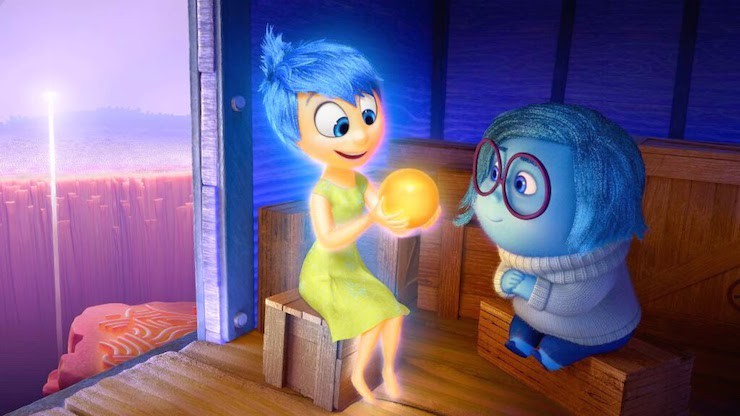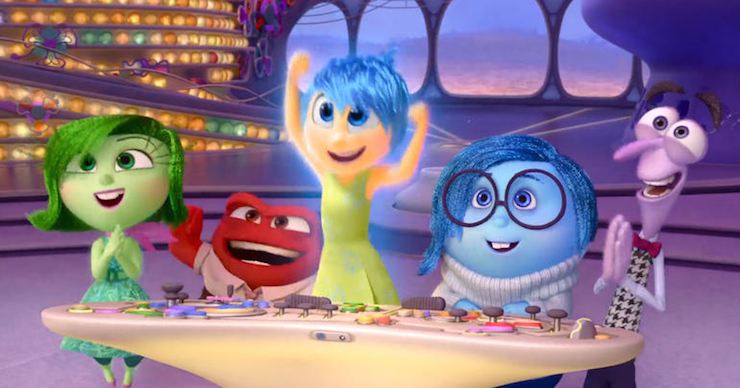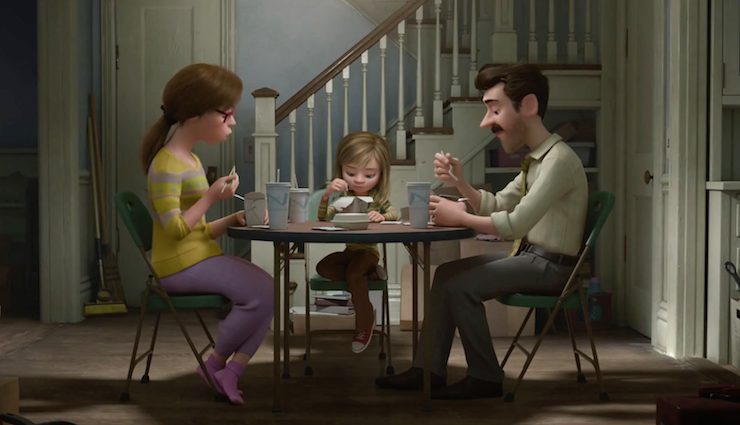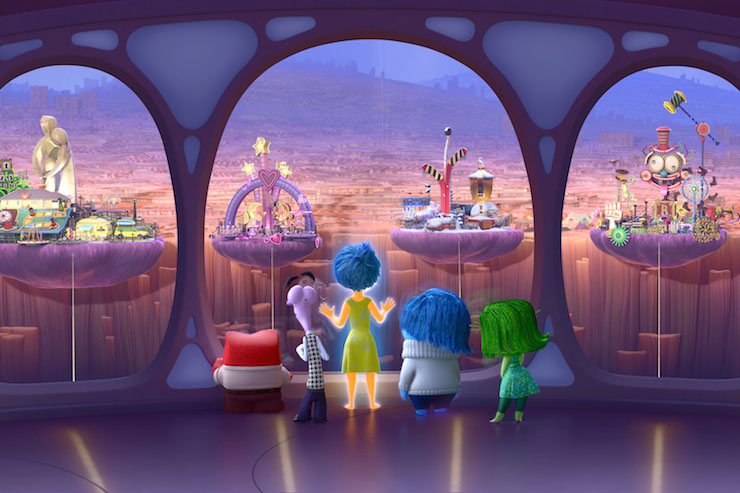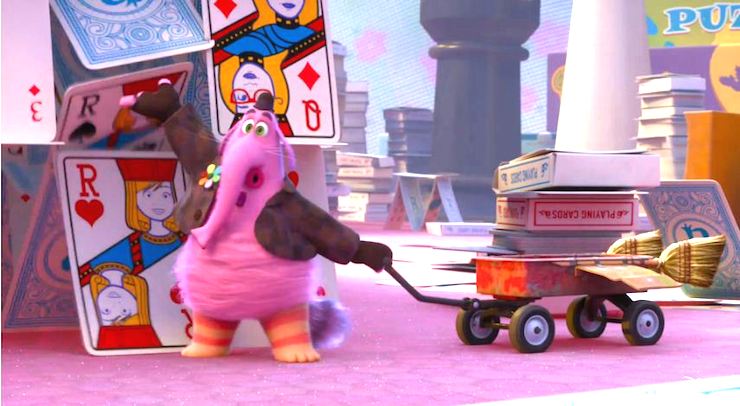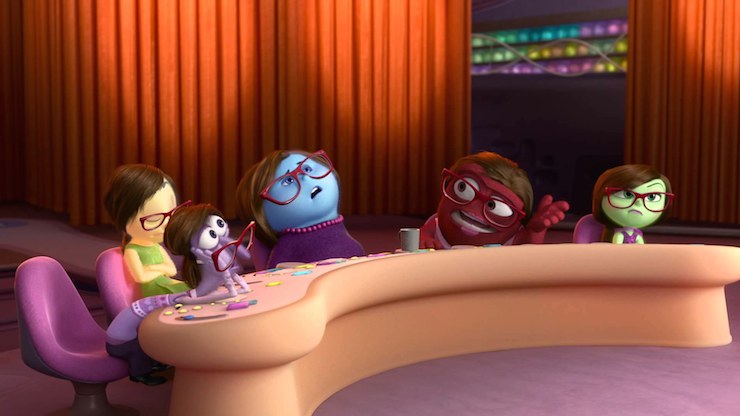Inside Out is already being hailed as Pixar’s best film in years, and it’s easy to understand why; the idea of delving into someone’s head and parsing out their emotions is a beautiful concept for a film meant to enchant and engage both children and adults. But while viewers were likely ready for something sophisticated—as Pixar’s pedigree comes with a great deal of expectation these days—they might not have been expecting a film that essentially functions as therapy for everyone lucky enough to see it.
(Spoilers for the film below.)
Inside Out focuses on eleven-year-old Riley, who has just been moved by her parents from Minnesota to San Francisco. This sizable change at a point in life when children are just beginning to mature sets off a flurry of chaos on her mind as she begins to confront loss, embarrassment, and pain on levels that she has never had opportunity to experience before. Inside her head are five core emotions; Joy, Sadness, Fear, Disgust, and Anger. (Writers at Pixar talked to psychologists and found that there was one other core emotion—surprise—but opted to leave that out of the film as it was too similar to fear.) They help Riley make her decisions, some of which form Core Memories that result in Islands of Personality, which essentially make Riley up as a person.
Joy, played by an effervescent Amy Poehler (it’s like having a little Leslie Knope in your brain!), has spent every moment of her existence focused on keeping her girl happy. Initially, she understands that most of the emotions play a role in keeping Riley alive; Disgust prevents Riley from getting poisoned, Fear keeps Riley safe from dangers while she navigates the world. Anger’s passion is also easily understood even when it isn’t exactly useful, but Sadness presents a conundrum to Joy, in that she seems to serve no helpful purpose at all.
Their problems start on Riley’s first day at her new school, when she’s asked to introduce herself in front of the class. When Riley calls up her happy life from Minnesota (featuring Core Memories), Sadness touches those memories without meaning to, tinging them with sadness and causing Riley to have a breakdown in class. This moment produces a new Core Memory, the first one to be created in a moment of sorrow. Joy isn’t having it, and the ensuing kerfuffle accidentally lands her and Sadness in one of the tubes that leads to Riley’s Longterm Memory, with her Core Memories in tow; with them both gone from Headquarters, it’s up to Fear, Disgust, and Anger to try and navigate Riley through life with none of those memories there to power her Islands of Personality. Riley is essentially diminishing as she remains disconnected.
Joy and Sadness are forced to work together to find their way back to HQ, meeting Riley’s old imaginary friend Bing Bong on the way. They pass through a few of her Personality Islands in an effort to get back, making it into Dream Productions when she falls asleep and they need to wake her. Back at Headquarters, things have been going horribly wrong, as the influence of Fear, Disgust, and Anger have guided Riley further into her sense of displacement. They eventually give her the idea to run away, back to her home in Minnesota, since Anger believes that’s the only place where she can form good Core Memories. Joy and Bing Bong eventually get lost in the Brain Dump, there to be forgotten permanently, until Bing Bong sacrifices himself to get Joy back to Longterm Memory. Finally understanding the purpose of Sadness, Joy gets them both back to Headquarters before Riley makes it out of San Francisco. She lets Sadness take the lead, giving Riley the ability to tell her parents that their “Happy Girl” isn’t happy here, and getting her the family support she needs to navigate this new situation.
What makes this movie so unique is its deft look at emotional development through Joy’s eyes. The film frames Joy’s difficulty with Sadness as an issue of context; when we’re very young, being sad is rarely a logical thing. We have blogs like Reasons My Son is Crying to prove that. Joy takes issue with Sadness because she can see no purpose behind her role in Riley’s mind—she just seems to muck up perfectly good experiences. The film doesn’t bother to explain why Sadness suddenly has the urge to touch all of Riley’s good memories and tinge them her particular shade of blue. We’re left to extrapolate how emotions evolve in life, how memories that were once dominated by a single overpowering feeling gain complexity, and are suddenly written over with many other powerful emotions. By the end of the film, Riley’s experiences are tinged with the colors of every emotion, indicating her development into a more mature, aware human being.
The film is also remarkable for knowing not to equate sadness with depression as though they are one and the same. In fact, the film is genius in differentiating the two; Joy learns that Sadness is a useful emotion to deploy in life, allowing a deeper connection with others, but depression is a different monster altogether—when Riley gets on the bus to run away to Minnesota, the “console” of her mind (the place where her emotions navigate her responses) goes gray and freezes over. The metaphor for depression is not about feeling sad, but about being numb and caught in a repetition of that numbness.
Sadness’ journey in the film is likely to give a whole generation of children a new way of communicating their stresses. In fact, the message contained in Inside Out is a particularly meaningful one in an age when humanity’s obsession with perpetual happiness might be hindering our development on a large scale. Joy (appropriately like so many parents in this day and age) wants Riley’s every day on Earth to be full of delight, failing to understand that sadness is essential due to its ability to signal others; when we’re sad, others respond by attempting to bolster us. To that effect, sadness is a natural step to finding happiness. But more importantly, the film doesn’t shy away from the idea of working through sadness as a fulfilling experience on its own. When Bing Bong is crying over the loss of the rocket he and Riley built together, Joy attempts to get him going with positive reinforcement, which does nothing. Then Sadness sits beside him and validates his right to feel that pain by allowing him to live with it for a moment, to let his sorrow breathe and sink in. After some time, Bing Bong is capable of righting himself and coming to their aid again. Joy is confused as to why this method worked when hers didn’t, but Sadness is simply doing her job—letting others process the unhappy parts of life.
Bing Bong’s role in the film, and his eventual sacrifice also hit hard in this glimpse of the working mind. He helps Joy and Sadness out of a desire to come out of retirement, to reunite with Riley’s consciousness and go on more adventures. But his decision to save Joy at the expense of his own existence (he stays in the Brain Dump to be permanently forgotten) tells a far more poignant tale; that imaginary friends—and imagination altogether—are forms of protection, and that they continue to fulfill that role, even if we’re not consciously calling on their help.
Because we can witness Riley’s experiences in the film, Inside Out works on micro and macro levels. While we watch Joy learn to appreciate the purpose of Sadness, we also watch Riley’s parents learn a valuable lesson; their Happy Girl can’t always be happy just because they need or want her to be. As she becomes a more intricate, nuanced person, they’re going to have to look harder for signs of distress. The film is explicit in its acknowledgment of family as a part of emotional development, but it does so without being preachy or cloying on the subject. People are shaped by relationships with other people; the stronger those bonds are, the easier it is to grow.
The film is also dizzyingly funny, from it’s analysis of our more base emotions to explanations for why you sometimes just can’t get a song out of your head, and all of that works together to make a truly delightful piece of cinema. I have some questions that were never quite answered to my satisfaction—for example, I’m curious as to why Riley seems to have a mix of genders for the emotions in her head, while all the adult seem to have emotions of the same gender; is this just dependent on the person, or is the suggestion that we become more gendered in our thinking as we age? Either answer would be an interesting one. All this really demands are more viewings of the film, which is layered enough to demand second and third and fourth looks.
But in the end, what sets this movie apart is its ability to thoroughly educate its audience via entertainment. After seeing Inside Out, the rest of my day was kind of rough, and my wife glanced over to my corner of the couch that evening and said, “Sadness is pushing all the buttons in your brain today, huh?” And I realized just how useful this movie will be to generations of viewers. It can give so many people a clear and simple vocabulary to deal with their emotions. It has all the benefits of good therapy packed into an adventure that tours the inside of a little girl’s mind. If you do yourself no other favors this summer, go see it. You deserve that catharsis too.
Emmet Asher-Perrin will be in the corner crying over her imaginary friends. You can bug her on Twitter and Tumblr, and read more of her work here and elsewhere.










